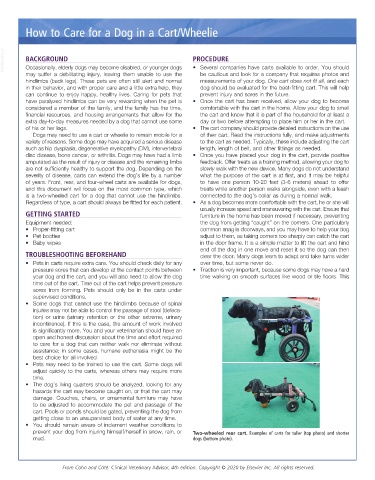Page 3176 - Cote clinical veterinary advisor dogs and cats 4th
P. 3176
How to Care for a Dog in a Cart/Wheelie
VetBooks.ir BACKGROUND PROCEDURE
• Several companies have carts available to order. You should
Occasionally, elderly dogs may become disabled, or younger dogs
may suffer a debilitating injury, leaving them unable to use the be cautious and look for a company that requires photos and
hindlimbs (back legs). These pets are often still alert and normal measurements of your dog. One cart does not fit all, and each
in their behavior, and with proper care and a little extra help, they dog should be evaluated for the best-fitting cart. This will help
can continue to enjoy happy, healthy lives. Caring for pets that prevent injury and sores in the future.
have paralyzed hindlimbs can be very rewarding when the pet is • Once the cart has been received, allow your dog to become
considered a member of the family, and the family has the time, comfortable with the cart in the home. Allow your dog to smell
financial resources, and housing arrangements that allow for the the cart and know that it is part of the household for at least a
extra day-to-day measures needed by a dog that cannot use some day or two before attempting to place him or her in the cart.
of his or her legs. • The cart company should provide detailed instructions on the use
Dogs may need to use a cart or wheelie to remain mobile for a of their cart. Read the instructions fully, and make adjustments
variety of reasons. Some dogs may have acquired a serious disease to the cart as needed. Typically, these include adjusting the cart
such as hip dysplasia, degenerative myelopathy (DM), intervertebral length, length of belt, and other fittings as needed.
disc disease, bone cancer, or arthritis. Dogs may have had a limb • Once you have placed your dog in the cart, provide positive
amputated as the result of injury or disease and the remaining limbs feedback. Offer treats as a training method, allowing your dog to
are not sufficiently healthy to support the dog. Depending on the slowly walk with the new device. Many dogs do not understand
severity of disease, carts can extend the dog’s life by a number what the purpose of the cart is at first, and it may be helpful
of years. Front, rear, and four-wheel carts are available for dogs, to have one person 10-20 feet (3-6 meters) ahead to offer
and this document will focus on the most common type, which treats while another person walks alongside, even with a leash
is a two-wheeled cart for a dog that cannot use the hindlimbs. connected to the dog’s collar as during a normal walk.
Regardless of type, a cart should always be fitted for each patient. • As a dog becomes more comfortable with the cart, he or she will
usually increase speed and maneuvering with the cart. Ensure that
GETTING STARTED furniture in the home has been moved if necessary, preventing
Equipment needed: the dog from getting “caught” on the corners. One particularly
• Proper-fitting cart common snag is doorways, and you may have to help your dog
• Pet booties adjust to them, as taking corners too sharply can catch the cart
• Baby wipes in the door frame. It is a simple matter to lift the cart and hind
end of the dog in one move and reset it so the dog can then
TROUBLESHOOTING BEFOREHAND clear the door. Many dogs learn to adapt and take turns wider
• Pets in carts require extra care. You should check daily for any over time, but some never do.
pressure sores that can develop at the contact points between • Traction is very important, because some dogs may have a hard
your dog and the cart, and you will also need to allow the dog time walking on smooth surfaces like wood or tile floors. This
time out of the cart. Time out of the cart helps prevent pressure
sores from forming. Pets should only be in the carts under
supervised conditions.
• Some dogs that cannot use the hindlimbs because of spinal
injuries may not be able to control the passage of stool (defeca-
tion) or urine (urinary retention or the other extreme, urinary
incontinence). If this is the case, the amount of work involved
is significantly more. You and your veterinarian should have an
open and honest discussion about the time and effort required
to care for a dog that can neither walk nor eliminate without
assistance; in some cases, humane euthanasia might be the
best choice for all involved.
• Pets may need to be trained to use the cart. Some dogs will
adjust quickly to the carts, whereas others may require more
time.
• The dog’s living quarters should be analyzed, looking for any
hazards the cart may become caught on, or that the cart may
damage. Couches, chairs, or ornamental furniture may have
to be adjusted to accommodate the pet and passage of the
cart. Pools or ponds should be gated, preventing the dog from
getting close to an unsupervised body of water at any time.
• You should remain aware of inclement weather conditions to
prevent your dog from injuring himself/herself in snow, rain, or Two-wheeled rear cart. Examples of carts for taller (top photo) and shorter
mud. dogs (bottom photo).
From Cohn and Côté: Clinical Veterinary Advisor, 4th edition. Copyright © 2020 by Elsevier Inc. All rights reserved.

